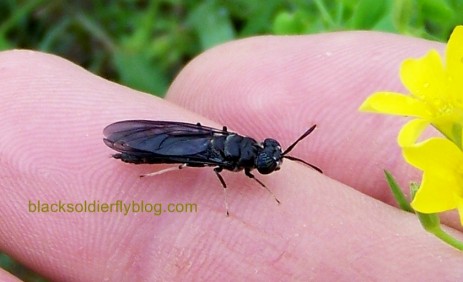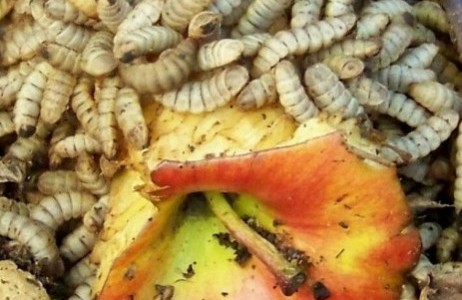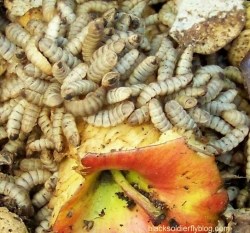 Adult black soldier fly.blacksoldierflyblog.comBlack soldier fly larvae are all the rage in composting, and the star performer in a new kind of “ultimate vermicomposting” system. These critters will devour anything biological that you can throw at them, including items that normally cannot be composted and instead end up in the trash, so called ‘putrescent’ wastes like meat scraps and dairy. And what you wind up with is big fat delicious grubs, perfect food for chickens or fish in a charming and tasty backyard closed loop system. And on a larger scale, their culture could help towns and cities deal with the mountains of putrescents that now go to landfills.
Adult black soldier fly.blacksoldierflyblog.comBlack soldier fly larvae are all the rage in composting, and the star performer in a new kind of “ultimate vermicomposting” system. These critters will devour anything biological that you can throw at them, including items that normally cannot be composted and instead end up in the trash, so called ‘putrescent’ wastes like meat scraps and dairy. And what you wind up with is big fat delicious grubs, perfect food for chickens or fish in a charming and tasty backyard closed loop system. And on a larger scale, their culture could help towns and cities deal with the mountains of putrescents that now go to landfills.
So I interviewed a man known for dabbling with the fly, Scott Kellogg, who is co-author of the book Toolbox for Sustainable City Living: A Do-it-Ourselves Guide and the primary teacher of R.U.S.T. — The Radical Urban Sustainability Training, an intensive weekend workshop in urban ecological survival skills. Currently, Scott is developing a new organization in Albany, N.Y. the Radix Ecological Sustainability Center. It is planned to be a demonstration of environmental technologies and sustainable micro industries applicable in today’s urban environment, like black soldier fly (BSF) systems.
Scott, what is a black soldier fly?
A black soldier fly (Hermetia Illucens) is an insect species found commonly throughout the U.S. As an adult, it neither bites nor stings nor eats, and in fact does not even have a mouth. For this reason, it has no interest in food, and therefore does not enter human occupied buildings or spread disease like a common housefly.
What about them excites you?
The grub-like juvenile larvae of the black soldier fly have the capability to quickly devour many types of food wastes, including putrescent meat and dairy products, which are difficult to process in regular composting or through a worm composting system. The finished product can be used as a soil amendment.
To date this is more of a backyard pursuit, right? Where can the backyard composter learn more, online?
There is growing interest about black soldier fly composting on the web. www.blacksoldierflyblog.com is a great resource of people sharing their experiences with BSF. Additionally, we discuss BSF culture methods in our book, Toolbox for Sustainable City Living.
What’s the potential in composting putrescent wastes with them? What kind of materials are these?
There’s a lot of potential. Food waste items such as meat scraps and dairy products often pose a problem in standard composting, as they are difficult to break down, and commonly produce smells and attract flies if they are not processed quickly enough. For this reason, the management of putrescent wastes is a big hole in community composting operations. BSF can devour such wastes at such a rate that rotting smells will not be produced, and the pheromones put out by BSF larvae repel house flies.
What do you do with the pupae?
They can be used as a high protein feed for fish or chickens, and therefore can be critical components in a closed loop ecosystem. Additionally, there has been research done about the possibility of using BSF larvae as a fuel stock for biofuels — they are around 50 percent lipids in content. We may soon see people driving maggotmobiles.
Is pupae just a nice way to say ‘maggots?’
Yes. So is grub, larvae, “phonenix worm” or any of the other euphemisms. What’s important to remember is that they’re not house fly “maggots,” and will not spread disease. Admittedly, I was a little turned off the first time I saw BSF larvae in a compost pile, but after getting to know about how beneficial these insects are, I’ve grown to appreciate them.
The term ‘manure management’ doesn’t help the ‘ick’ factor perhaps. But what’s the potential there?
Again, huge. BSF can rapidly reduce the volume of any manure pile, and greatly reduce the risk of disease transmission from house flies.
Can you imagine BSF being used for other ‘putrescents?’
Sure. Dead animals, sewage, milkshakes. The sky’s the limit.
What kinds of regulatory or structural hurdles might have to be overcome at the municipal level for larger scale efforts?
Probably no more than those in place for a standard composting/vermicomposting operation. Such systems are so new, it’s likely that regulations don’t even exist for them.
Ever used them for bait?
No, but they’re sold online from a number of places as a fishing bait under the name “phoenix worms.”
Entomophagy isn’t everyone’s thing, but if one wanted to get BSF on the national map, how about inviting TV food adventurer Anthony Bourdain to snack on some in a red wine reduction? Or there could be a BSF eating contest between him and Andrew Zimmern. Discuss.
Most culinary traditions in the world aside from Western have some practice of entomophagy. Cooked BSF larvae could certainly be part of one. Because most people aren’t ready for that, using them indirectly to create palatable eggs and fish will be more likely to go over.
—
Learn more about the black soldier fly and order your very own BSF composting kit at http://blacksoldierflyblog.com
And check how fast the larvae take down this pile of cukes (there are a zillion other videos on YouTube, too):




